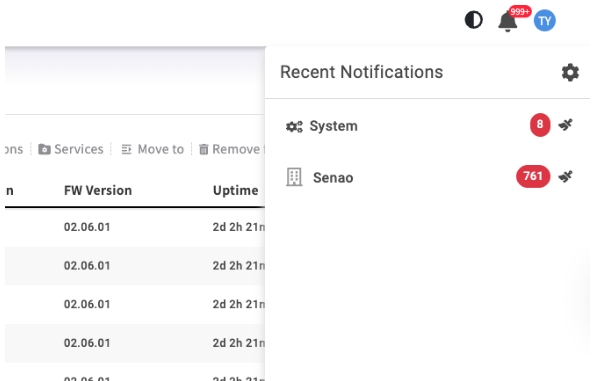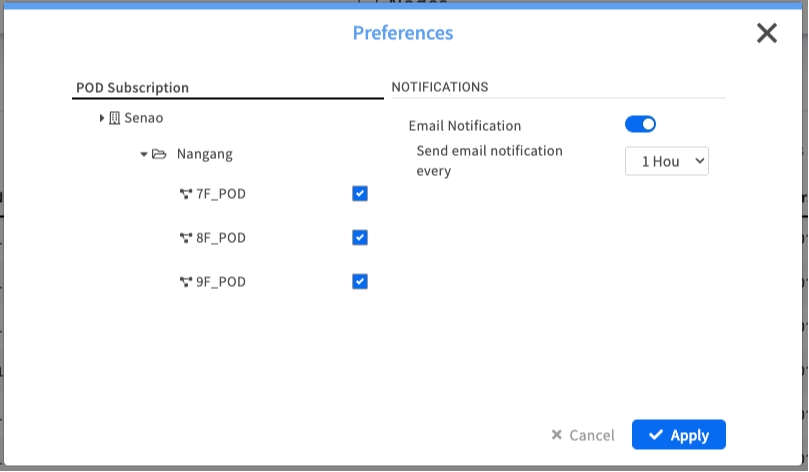Notification Centers
Chapter 17: Using the Notification Center
Learn how to monitor real-time events and customize your alert preferences using the Notification Center.
ℹ️ Notification Management
Available to: All user roles
Scope: Personal notification preferences
Permissions: Personal customization - all users can manage their own notifications
Access: Click bell icon () top-right corner of interface
Overview: Your Personalized Alert Feed
The Notification Center, accessed via the bell icon () in the top-right corner, is your personal, real-time feed of important events. It's designed to be a "heads-up display," giving you a quick summary of recent activities without requiring you to navigate to the full Event Log.
The content you see is always dynamically filtered based on your specific user permissions and your currently selected management scope.
Dynamic Filtering:
The same notification event may appear differently for different users based on their permissions, scope selection, and personal subscription preferences.
Task 1: Understanding and Using the Notification Center
Notification Center vs. Event Log: What's the Difference?
It's important to understand when to use the Notification Center versus the main Event Log (Chapter 14).
Purpose
Quick summary & real-time alerts
Deep investigation & auditing
Data
Filtered, user-centric feed
Complete, official record
Management
Can be marked as "read"
Read-only, cannot be changed
Scope
Personal, permission-based filtering
Organization-wide comprehensive log
Best Used For
Daily monitoring and immediate awareness
Detailed investigation and compliance audits
Accessing Your Notifications
Basic Access:
Visual Indicator: Look for the bell icon () with red badge showing unread count
Open Panel: Click the bell icon () to open the Notification Center
Quick Scan: Review categories and recent events
Close: Click outside the panel or press Escape to close

Task 2: Managing Your Daily Notifications
Daily Notification Workflow
Recommended Daily Routine:
Check Badge Count: Look for red badge on bell icon
Review New Alerts: Click to open Notification Center
Prioritize by Category: Check System notifications first, then Management Scope
Mark as Read: Clear reviewed notifications to maintain clean feed
Investigate Critical Items: Navigate to full Event Log for detailed investigation if needed
Understanding Notification Categories
System
Platform-wide events and Organization-level administrative actions (e.g., new user invited, EDCC software update complete)
All users: Software updates, user management, system maintenance
Management Scope
Events specific to your authorized Organizations, HVs, and PODs (e.g., "Device: Node-ABC goes offline," "Change Timezone to Prod_POD")
Filtered by permissions: Node status changes, POD configuration updates
Permission-Based Filtering
How Content is Filtered:
User Role: Your permission level determines which types of events you can see
Management Scope: Currently selected scope affects which POD-specific events appear
POD Access: You only receive notifications from PODs you have access to
Personal Subscriptions: Your Preferences settings further filter the content
Task 3: Customizing Your Alert Preferences
Accessing Notification Preferences
Process:
Open Notification Center by clicking bell icon ()
Click the gear icon ( ) in the top-right corner of the panel
Configure your preferences in the dialog

POD Subscription: Focusing on What Matters
Purpose: Essential for administrators who manage many PODs but only need to be actively alerted about a critical few. Allows selective subscription to specific PODs.
How it Works:
View a tree of all management scopes you are authorized to access
Check or uncheck boxes next to each POD to subscribe or unsubscribe
Changes apply immediately to your notification feed
Configuration Strategy:
Organization Admin
Subscribe to all critical PODs, unsubscribe from development/test environments
POD Admin
Focus subscriptions on assigned PODs only to reduce notification noise
POD Viewer
Subscribe only to PODs relevant to monitoring responsibilities
Use Case Example:
An administrator responsible only for Production_POD can unsubscribe from Dev_POD and Test_POD to ensure their notification feed is only populated with alerts relevant to their duties.
Email Notifications: Staying Informed Offline
Purpose: Allows EDCC to send notifications directly to your email address, ensuring you stay informed of critical events even when not logged into the platform.
Configuration Options:
Email Notification Toggle
On/Off
Master switch for all email alerts
Frequency Dropdown
Every 1 Hour, Every 24 Hours, Weekly
Balance between immediacy and interruption
Frequency Recommendations:
Hourly: For Organization Admins monitoring critical infrastructure
Daily: For POD Admins with regular monitoring responsibilities
Weekly: For Viewers or administrators of stable environments
SMTP Dependency:
Email notifications require properly configured SMTP server in System > Application Settings. Without SMTP configuration, the Notification Center becomes your primary and essential source for all alerts.
Managing Notification Volume
Reducing Alert Fatigue
If you find yourself overwhelmed by notifications:
Unsubscribe from non-essential PODs: Use Preferences to focus on PODs you actively manage
Adjust email frequency: Reduce from hourly to daily or weekly digests
Use scope filtering: Switch Management Scope to focus on specific areas
Key Integration Points
Dashboard alerts derive from same events: Critical notifications often correspond to Dashboard health indicators
Event Log provides details: Use Notification Center for awareness, Event Log for investigation
Scope selection affects content: Changing scope dynamically filters notification history
Chapter Summary & Key Takeaways
Personal Alert Management: Use the bell icon for quick, real-time summary of events filtered specifically for your permissions and preferences
Complement to Event Log: Use Notification Center for daily awareness, Event Log for detailed investigation and compliance auditing
Customization is Key: Configure Preferences to subscribe only to relevant PODs and set appropriate email frequency to reduce noise
SMTP Dependency: Email notifications require Organization Admin to configure mail server in System > Application Settings
Permission-Based: Content dynamically filters based on your role, scope selection, and personal subscriptions
Daily Integration: Incorporate notification checking into your daily operational routine for proactive issue awareness
What's Next: This completes the main EDCC functionality coverage. Refer to the Appendices for additional reference materials and troubleshooting guidance.
💡 Pro Tip: Start each day by checking your Notification Center - it's the fastest way to identify any issues that developed overnight or during off-hours.